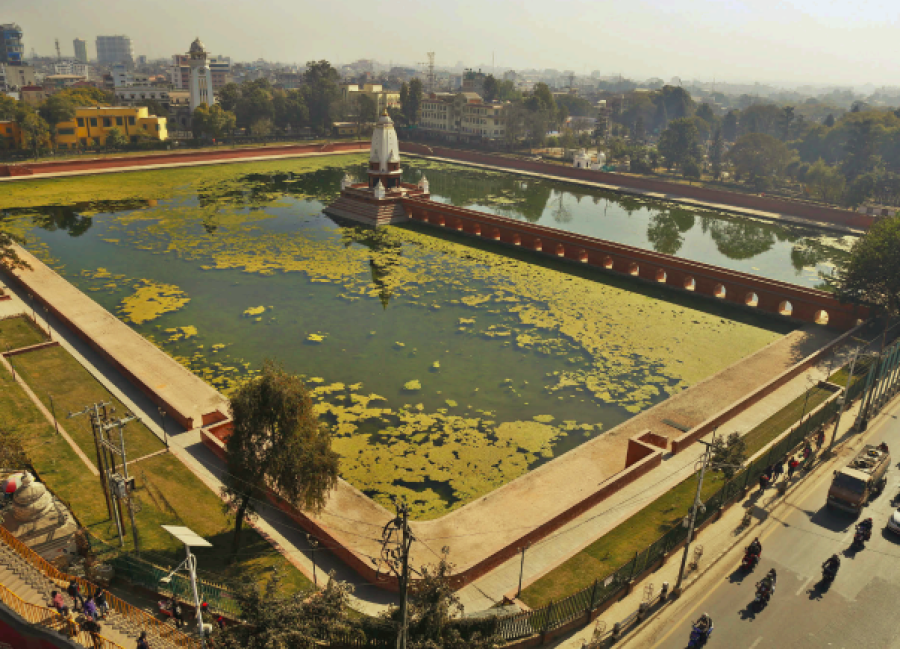Valley
Rani Pokhari is covered with algae, officials don’t have concrete plans to clean it
Conservationists say problem arose as the pond does not have an outlet. They suggest use of natural methods such as introduction of fish to remove the algae naturally.
Anup Ojha
Until October last year, the iconic Rani Pokhari, spread over 7.7 acres at the heart of Kathmandu, didn’t have any water in it.
But later in the month, water was replenished using water from the Bagmati and rainwater harvesting, just before the reconstructed pond was inaugurated by President Bidya Devi Bhandari.
The completion of the pond’s restoration was seen as a great achievement for both conservationists and local residents who relentlessly raised their voice against the Kathmandu Metropolitan City’s earlier decision to concretise the pond.
But two months after the restoration of the landmark pond constructed by Pratap Malla, officials are indifferent towards the sustainable preservation of the historical monument. The pond’s clear water is now covered with algae.
“When President Bhandari inaugurated Rani Pokhari, it looked clean, but now it is covered with green algae,” said Surya Mani Paudel, who runs a bookstore at Bhota Hiti.
“After the pond was reconstructed, I had started going to the overhead bridge nearby, to look at the pond, which was really beautiful,” he said.
“I would do a round of the pond for my morning walk. But I don’t feel like doing it now,” said Paudel, 43.
After the Kathmandu Metropolitan City failed to complete the reconstruction work, the Cabinet in January 2018, handed over the reconstruction work of Rani Pokhari, Balgopaleshowr Temple, and other structures of the pond to the National Reconstruction Authority.
The authority said it has cleaned the pond three times, and each time spent around Rs70,000. But algae have grown back every time.
The sorry state of the historic pond has worried heritage conservationists and campaigners. It was due to their continuous protest and lobbying that the Balgopaleshwor temple, situated at the middle of the pond, was constructed in the Shikhara style—the way King Pratap Malla had constructed it in 1670 AD.
“They are misusing the public’s hard-earned money. Before the pond was inaugurated, we had reminded the NRA about keeping the pond clean and requested it to consult experts before making a big announcement about its restoration,” said Sanjay Adhikari, a campaigner advocating for the restoration of Rani Pokhari in its original form.
Sushil Shrestha, president of Traditional Hiti and Pond Conservation Organisation, said algae grows in the pond as it lacks an outlet. “It’s very obvious that when water is stagnant, algae will grow,” Shrestha.
He gave examples of two recently restored ponds in Purnachandi and Pimbahal to explain. “Come and see these two ponds in Lalitpur, they are free of algae because we have water outlets and we have introduced fish there,” said Shrestha.
He said the best way to get rid of algae is to introduce grass carp, silver carp, and other kinds of fish that eat algae.
When the Post contacted the NRA to inquire about the pond, officials said the pond is yet to be handed over to the Kathmandu Metropolitan City.
“Regarding the algae, we are trying to remove them using natural processes such as aeration. We are not going to use any chemicals that may harm aquatic life,” said Raju Man Manandhar, a person assigned by the authority to oversee the restoration project.
He said the NRA is planning to monitor the Ph level of water in Rani Pokhari. “If we can reduce the Ph level to 6.8-7, it will become suitable for aquatic life. We are going to use a Japanese wastewater treatment technology,” said Manandhar. But he didn’t not give details on when the technology was going to be used.
Manandhar said rain in the past few days also proliferated the algae in the pond. The NRA had added 18.5 million litres of water from the Bagmati to the pond before its inauguration.
Manandhar said that NRA was willing to hand over the task to the KMC a month ago, but Mayor Bidya Sundar Shakya said the city would take over only after the whole project was completed.
Work on the beautification of Shanti Batika in the southwest corner of the Ranipokhari and the development of open space to the north of the pond is yet to be completed, according to Manandhar.




 7.12°C Kathmandu
7.12°C Kathmandu.jpg)










